Island Peak Climbing
DURATION19 Days | ACTIVITYExpedition | MAX ALTITUDE | TRIP GRADEDifficult |
GROUP SIZEMin. 2-14 Pax. | AccommodationTea House / Camping | TRANSPORTFlight | BEST SEASONN/A |
Overview
Interested in doing an expedition in Nepal? If you are a beginner and want to climb mountains, then we are here with Island Peak Climbing. Grab an excellent opportunity to achieve Peak Summit (6,173 m) with the Everest base camp trek and Kala Patthar hiking. It is a popular expedition among both beginners and experienced trekkers and climbers. More than 300 groups used to climb the peak of the island each year. It's your turn to flourish in the upcoming best seasons: autumn or spring on the island peak.
Island Peak, also known as Imja Tse, is located on the top of Chukung Glacier between Ama Dablam and Mt. Lhotse. It is the best destination for amazing views of Imja Valley, nearby Mount Everest (8848.86 m), the highest peak in the world. Climbing the peak creates new climbers and adventurers within 18 days. Your experience on the challenging path, along with the EBC trekking and peak climbing, makes you not only a trekker but an explorer with a climber identity.
The Island Peak climbing itinerary begins the same as the Everest base camp trek. The thrilling Lukla flight lands you at the gateway to Everest. Starting the trek from Lukla, you will follow the bank of Dudh Koshi. Pine trails, monasteries, chortens, manes, and prayer flags make your path shorter with their beauty, even if you cover a long distance.
Beautiful Sherpa villages: Phakding, Manjo, Khumjung, Kaynjuma, and Sannasa, on the route to Island Peak base camp, will spread Sherpa culture. The wonderful view of Mt. Everest, Mt. Loshte. Mt. Loshte Shar, Ama Dablam, Tabuche, Cholache, Mt. Thamsekhu, Khakteka, and Khusum Khangagru from Tengboche, Pheriche, and onwards increase our enthusiasm with their heavenly appearance. It takes 17 days to complete the Everest base camp trek and climb Island Summit, followed by departure on the 18th day. Camping at the Island Peak base camp (5087 m) and high camp (5500 m) are the most challenging parts of the expedition.
The trail proceeds to Dingboche, you can continue towards Island Peak Base Camp, reverting from EBC trekking depending on your choice. However, Mission Summit Treks proposes to have Everest base camp first to get acclimatized before climbing.
Each day, the journey replaces the highest altitude, acclimatizes you, and welcomes you to new destinations around the Everest ranges. The view of Lhotse (8516 m), Mount Pumori (7161 m), Mera Peak, Mt. Barunste, and other surrounding peaks from the peak of the island is excellent.
Island Peak climbing itinerary in brief:
| Days | Activities | Elevation (m) | Distance (km) |
| 1 | Arrival in Kathmandu | 1,324 | |
| 2 | Preparation Day | 1,324 | |
| 3 | Fly to Lukla then Trek to Phakding | 2,610 | 8 |
| 4 | Trek To Namche | 3,440 | 11.5 |
| 5 | Acclimatization Day at Namche | 3,440 | |
| 6 | Trek to Tengboche | 3,860 | 13.5 |
| 7 | Trek to Pheriche | 4,371 | 8.5 |
| 8 | Trek to Lobuche | 4,910 | 7 |
| 9 | Trek to Gorakshep & EBC | 5,364 | 12 |
| 10 | Hike to Kala Pather and Back to Dingboche | 4,410 | 17 |
| 11 | trek to Chukhung | 4,730 | 8 |
| 12 | Trek to Island Peak Base camp | 5,100 | 6 |
| 13 | Trek to the High camp of Island Peak | 5,500 | 3 |
| 14 | Summit Day & back to base camp | 6,160 | 10 |
| 15 | Base camp to Tengboche | 3,840 | 13.5 |
| 16 | trek to Namche | 3,440 | 13.5 |
| 17 | Trek to Lukla | 2,860 | 19 |
| 18 | Fly back to Kathmandu (KTM) | 1,324 | |
| 19 | Final Departure |
Trip Highlight's
- The world’s highest peak, Mt. Everest (8,848 m above mean sea level),
- View the highest peak above 8000M from top (Lhotse, Makalu)
- Mt. Everest Base Camp and Kala Patthar
- Khumbu glaciers and Khumbu Icefall
- Khumjung and Namche villages
- Snow Leopard, Musk Deer, Red Panda, and Himalayan Monal
- Get a chance to Explore Sherpa culture and village
- Monastery (Tengboche and Khumjung)
- climbing Experience
Island Peak Climbing Itinerary
As you arrive at Tribhuvan International airport, Nepal, our company member will welcome you and drop you at the hotel. In the evening you will meet your guide and have a welcome dinner with company members in the cultural restaurant. You can talk about your trip with your guide as well.
Night stay at the hotel.
The second day is for trek preparation, and buying the necessary requirements for a mountain climb. You will visit Thamel with your guide, and all information about the requirements to climb will be given by the guide.
If you get extra time, then you can visit Kathmandu Durbar Square, Bouddhanath as well.
Trekking begins as you reach Lukla from your morning flight and have breakfast. A four-hour walk on the bank of Dudhkoshi, a stone-paved path between houses, Chorten, and suspension bridges over Dudhkoshi took you to Pakhding.
Pakhding is a small and beautiful village rich in hotels and tea houses. You will take lunch in one of the tea houses and rest.
Your delightful mountain flight, 4-hour walk in the peaceful Everest region, the divine nature with creeping birds, the burble of a flowing river, the players flag, and the monastery make your day wonderful.
Leaving Pakhding with delicious breakfast, your walk begins from the bank of Dudhkoshi. Following uphills and downhills, crossing suspension bridges, you will reach Monjo village.
Monjo village is in Sagarmatha National park. There is a checkpoint at which you should get a permit for trekking in the Everest region. The pine trial and stone-paved path continue until you reach Namche.
Namche, the Himalayan Thamel is a small town with high development. Market with ATM, well-fascinated hotels, restaurant and bar, small cottage industry, tea houses, colourful building with Buddhist culture, Sherpas hospitality makes the place more beautiful.
In the evening you will visit Namche Bazaar but it is upon your body condition. If you are tired, you can take a rest as well.
Night stay in tea house of Namche Bazaar.
To acclimatize your body, we will stay in Namche bazaar today. We will have breakfast and visit Khumjung Valley (3,790m). It takes just 1.5 hours to reach Khumjung valley from Namche. If we get more time we will also visit the Everest view Hotel standing at 3800m. The clear view of Mount Everest from the hotel and its position at the highest altitude makes it more special.
After returning from Khumjung valley we will have lunch and take a rest. We need proper rest to make our body fit for the further days walk.
Night stay at tea house of Namche Bazaar.
We will begin our walk towards Tengboche early in the morning for a panoramic view of Mt. Everest, Mt. Loshte. Mt. Loshte shar, Amma Doblam, Tabuche, Cholache, Mt. Thamsekhu, Khakteka, Khusum, and Khangagru from the trial. During the daytime, the view may hide behind the clouds.
We will pass Kaynjuma village, Sannasa, and Phungi Thanga then reaches Thengboche after 6 hours from Namche. You will see the oldest monastery called Tengboche, the place has been named after this monastery. Different chorten, mani walls and prayers flag give a glimpse of Buddhism.
Somewhere you will see raring yak, Georges deep below, and somewhere snowy landscape. The path to Tengboche is more plan less vertical uphill and downhill, so-called as best trial of Everest base camp as well as Island peak climbing.
Night stay in tea house of Tengboche
Today we will wake up quite earlier so that the best mountainous scene from Thengboche will not be missed. After taking photographs we will have breakfast with a majestic view of the snowcapped Highest Mountain and nearby ranges.
Our walk begins on downhill from Thengboche and reaches Dingboche after 20 min. After crossing the river you will see different mani walls, chorten, stupa and reach Pagboche.
Upper Pagboche is Sherpa village whereas lower Pangboche is more famous for tourism. The great view of Amadablam along with the burble of river creates a peaceful environment. You will pass Somer after uphill and walk on the way to Pherichhe.
30 minutes of walk with the cold breeze and peace in you, destination Pherichhe welcomes you.
Night stay in tea house of Pherichhe.
High altitude and rocky path add more challenges but the trail from Pheriche to Lobuche is easy. Even the trail is easy we should keep calm and walk slowly to maintain our health condition and save our own self from altitude sickness.
After having breakfast we will walk slowly enjoying the scenery being in our comfort zone. The raring yak, shepherd, and yekshed makes Himalayan life alive, we become an explorer.
Our path continues uphill, we will cross the river and reach Thukla. You can take a rest here if you become tired. The less oxygen zone really becomes a challenge, thus you have to be quite careful and mentally strong. We will pass the monument, and finally reach Labuche after four hours from Phrichhe.
Night stay in Labuche.
After having breakfast in Lobuche we will head toward Gorakshep, the last destination with tea houses. We will start walking early in the morning so that we can spend more time on Everest base camp.
The rocky trial on high altitude passes as we move ahead. You may feel difficult to breathe due to altitude but slow walking, long breathing and an acclimatizing body will favor you.
With a view of Everest, Numste, Khubuste, Chagaste, Mount Pumori, Labuche peak very near to us, we will reach Gorak Shep after 2, 3 hours from Lobuche. After keeping bags and taking rest on tea house we will walk towards Everest base camp.
Around 1.45 min walk on glacier path take us to Everest base camp. Yes you will be in front of Everest, the highest peak of the world stand just close to your eye. We will spend around 1 hour on EBC, take videos, photos and return back to Gorekshep.
Night stay in Gorekshep
Very early in the morning, at around 4:30 am we will leave Gorekshep to reach Kalapather for sunrise view. As we move ahead from Gorekshep the clear view of Mount Everest, Lhotse, Nuptse and Pumori attracts us, some of the trekkers return after viewing Everest but It is more better to reach Kalapathar for sunrise view.
Rising sun behind the Mountain and spreading its rays on the snowcap really gives mind blowing scene. Capturing the moment in video and photographs, we will return back to Gorekshep for breakfast.
Today’s target is to reach Dingbouche, thus we will pack our bag and start walk from Gorekshep. Descending down on the rocky path, we reach Dingboche enjoying the mountainous scene, snowy landscape and yak shed.
Night stay in Dingboche
After having breakfast in Dingboche, we ascend towards Chhukung. Only after three hours of walk we reach our destination. Chhukung is small village on the base of Island peak, specially developed for serving trekkers and climbers.
To acclimatize our body and being prepared for mountain climb, we take rest on tea house of Chhukung. We will arrange and gathere all the required equipments for mountain climb on Chhukung.
Night stay at tea house of Chhukung.
Chhukung to Island Peak base camp trek begins with breakfast in the yard of Chhukung’s teahouse, with its mountainous surroundings. We will load all the climbing equipment and start our walk towards Island Peak Base Camp. It takes around five hours to reach the Island Peak base camp from Chukung. As we need various pieces of equipment to climb Island Peak, carrying all those by ourselves will be difficult. We will hire a yak or porter to carry that equipment up to basecamp.
The Imja valley, glacier lake, and Island Peak are the major highlights of today's trial. We will reach the base camp of Island Peak after five hours of walking. We will gather our equipment, arrange our tent, and take a rest. Today’s night is quite challenging, as we will spend a night in camp.
Finally, after twelve days of the trek, we will climb Island Peak. Leaving base camp after breakfast, we will start climbing the island peak. The condition of the weather determines when to start climbing. The snowy mountain ride, holding the rope, is a tough job and interesting as well. Before starting the climb, Sherpa will give instructions about using the tools and climbing the mountain.
After three hours, you will reach high camp, take a rest for a while, and arrange a tent. We will spend the night in a tent. The night in high camp, below the twinkling star, everywhere surrounded by snow, and tomorrow's peak climbing excitement. Here comes the memorable, great moment. It is important to drink plenty of water to hydrate your body, get proper sleep, and rest to reach the summit within 12 hours.
We will wake up early in the morning, make ourselves ready for the Island Peak summit climb. Before starting our climb, Sherpa will check the weather and give you guidelines.
Island Peak Summit (6189 m) climb is not an easy task, you will pass a rocky path with scrambles, sometimes zigzags, and sometimes steeps. Sherpa will guide you, your courage and confidence took you to the summit. Finally, you will step on the island peak summit. After spending some time on the summit and sharing the joy of a successful climb, you will come down to High Camp following the guidance of Sherpa.
Resting for an hour on High camp and taking a tent along with other equipment you will start walking towards Chhuking.
You will pass Island peak base camp, enjoy the Imja valley, Glacier and mountainous surrounding and reach Chhukung. You will leave climbing equipment on base camp to be brought by Yak or porter and submit all equipment on Chhukung.
After taking breakfast, we will descend towards Tengboche. Passing monasteries, Chorten, mane, and viewing Mt Everest, Amadablam, Nuptse, Lhoste, and other ranges, we will reach Tengboche after hours of walk.
Night stay in tea house of Tengboche.
From Tengboche, we will descend downhill, enjoy the easy trail, and reach Namche. It takes around five hours to reach Namche from Tengboche.
The trail will be quite common while returning back.
Night stay in Namche.
Following downhill through stone paved steps, passing Manjo and Pakhding village, you will trek to Lukla covering Namche bazzar to Lukla distance of 13.5km. The long journey come to the rest point with all beautiful events as memory.
It takes around 6 hours to reach on Lukla. The suspension bridge, Monastery, Chorten, rhododendron forest, mane, bank of Dudhkoshi, and the Himalayan screen turn off as you finish your trekking.
Night stay on Lukla
Early in the morning, we will pack our bags and be on our flight to Kathmandu. The mountainous flight offers a clear view of Himalayan ranges which memorize the joy of being on the summit of Island peak and base camp of EBC.
The Lukla flight to Kathmandu lands after 40min. We will check out from the airport and drive to the hotel.
After having rest for a few hours, you can have a visit to Thamel, shopping, and even have a short tour to Shyambunath as well. In the evening, you will have a farewell dinner with company members in the cultural restaurant.
Night stay at hotel
Depending on the time of the flight, our company member will drop you off at the airport. Until your departure, we will be with you.
In this way, climbing island peak and ebc trekking ends with a lifetime memory.
COST INCLUDES
THIS TRIP INCLUDES
Airport pickup and drop by private car/Van/Bus
Star Category accommodation in Kathmandu on Bed n breakfast
Flight from Kathmandu to Lukla and Kathmandu
Three meals (Breakfast, Lunch, and Dinner) during the trek
All accommodations during the trek. (Toilet will be outside your room)
All necessary paper works the Everest National Park entry permit
All permits for Island Peak climbing
All equipment for climbing (in Rent)
A helpful, knowledgeable, friendly, well-English-speaking trained, government license holder guide & porter With all his salary, food, drinks, and insurance.
Medical supplies (first aid kit will be available)
All government taxes and office expenses.
Trekking route map
Domestic Airport tax
THIS TRIP EXCLUDES
The Nepal entry visa fee is $40
International airfare/Your Travel insurance
Lunch/ Dinner in Kathmandu
Mineral water/bottles drinks/Sweets things during the trek.
Hot shower/Battery charge /WI-FI for the camera during the trek
Tips for Guide & Porter
Island Peak Climbing Cost and Date
Island Peak Climbing Cost and Date is provided in the checklist below to plan your holiday trip. Confirm your booking with us. We are flexible for customizing the trip. Contact us for your queries.
| DEPARTURE DATE | Price | Action |
|---|
Total Departure Dates: 0
Gallery
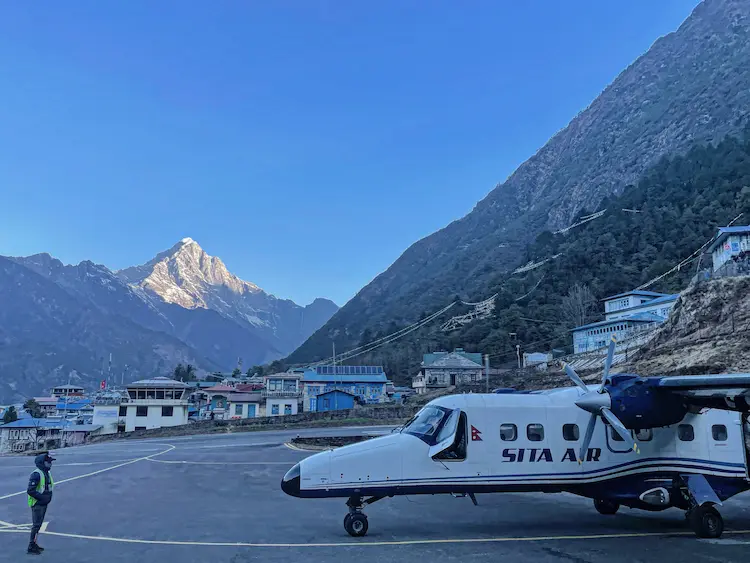
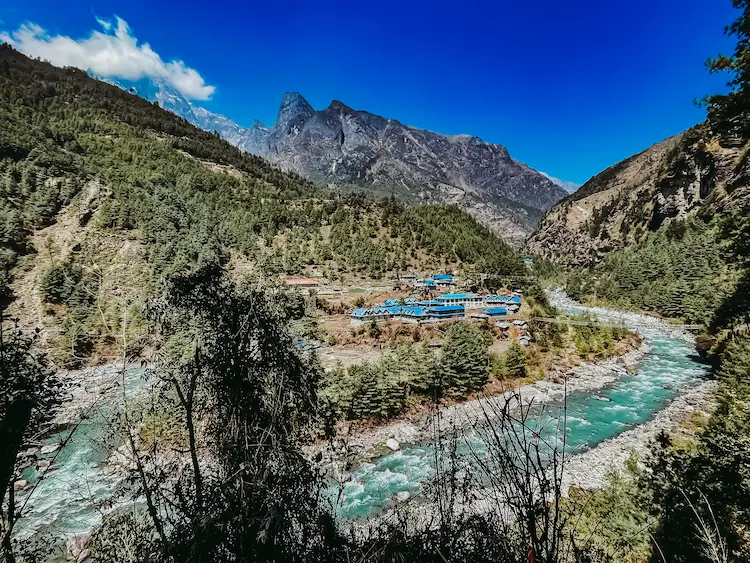
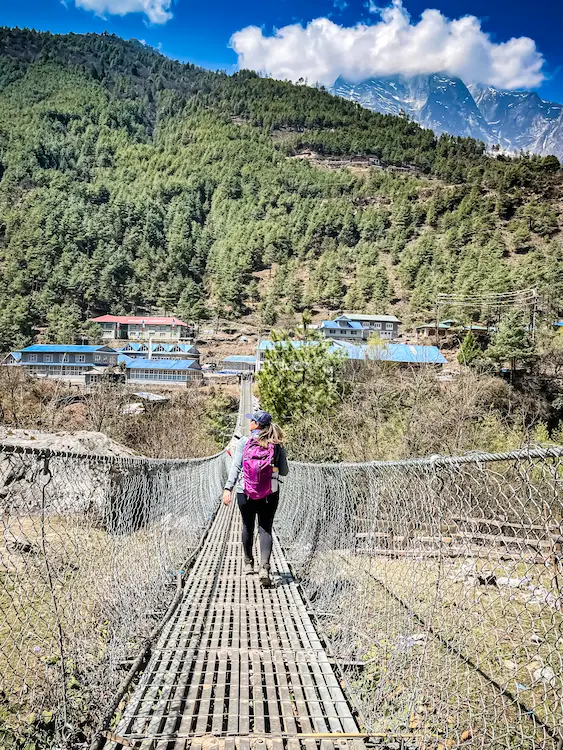
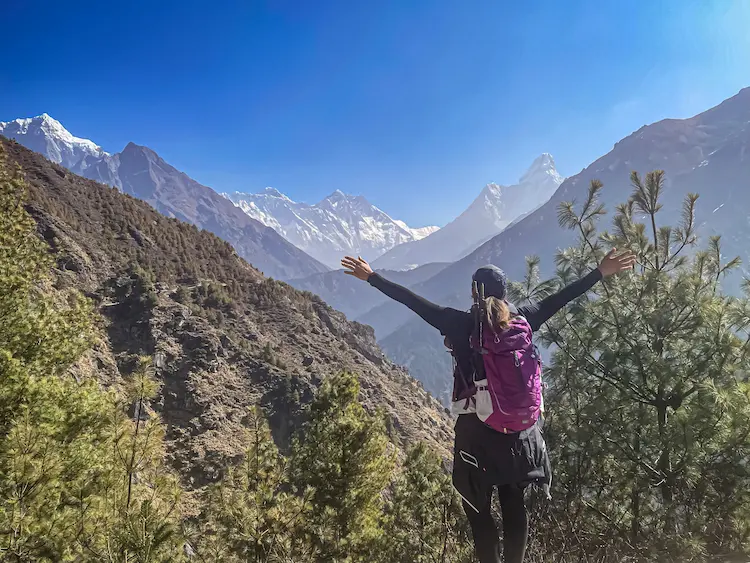
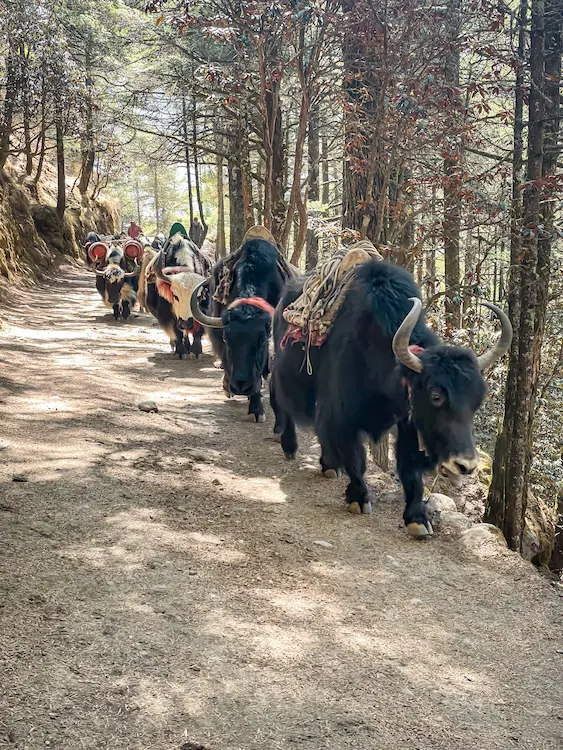
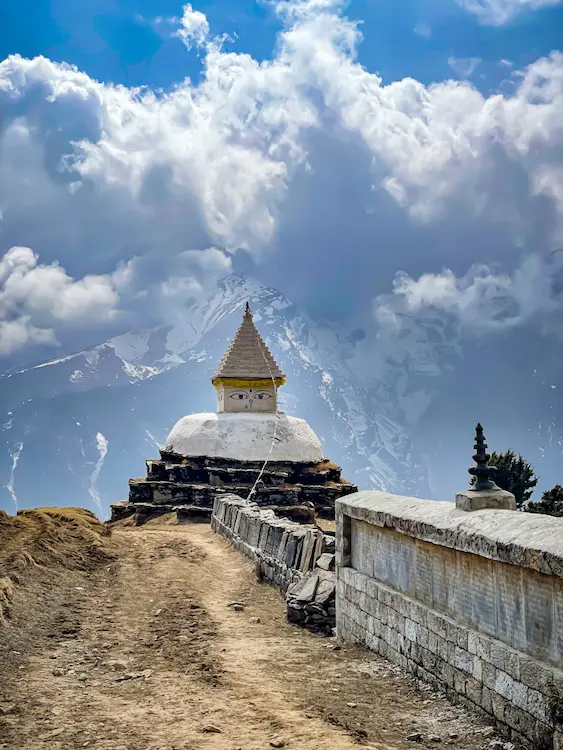

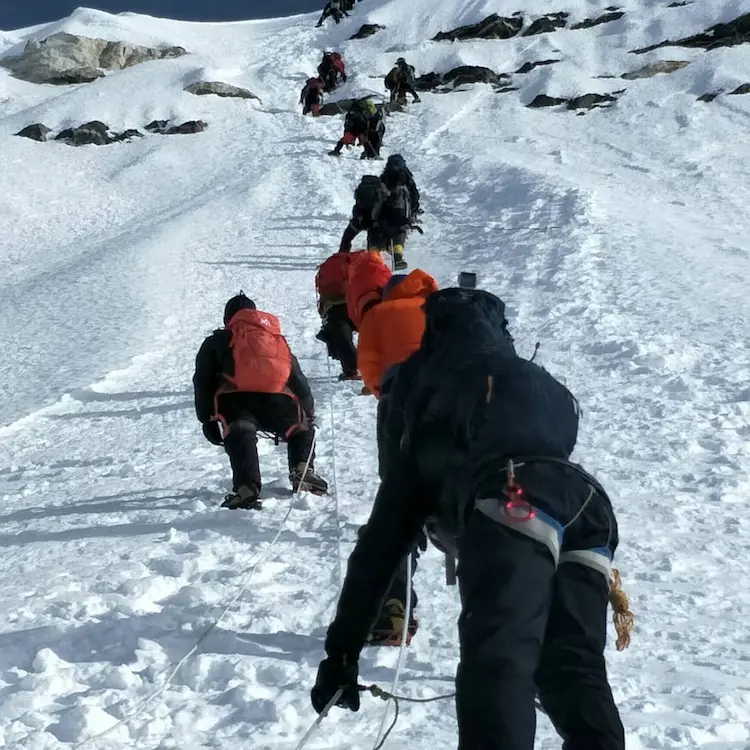
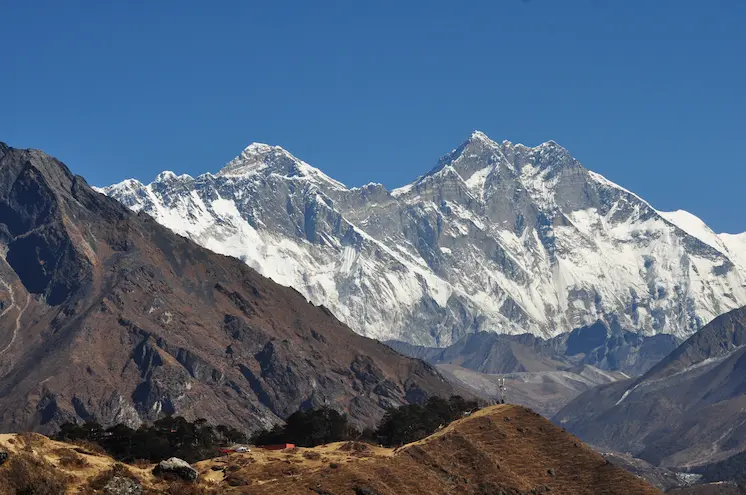
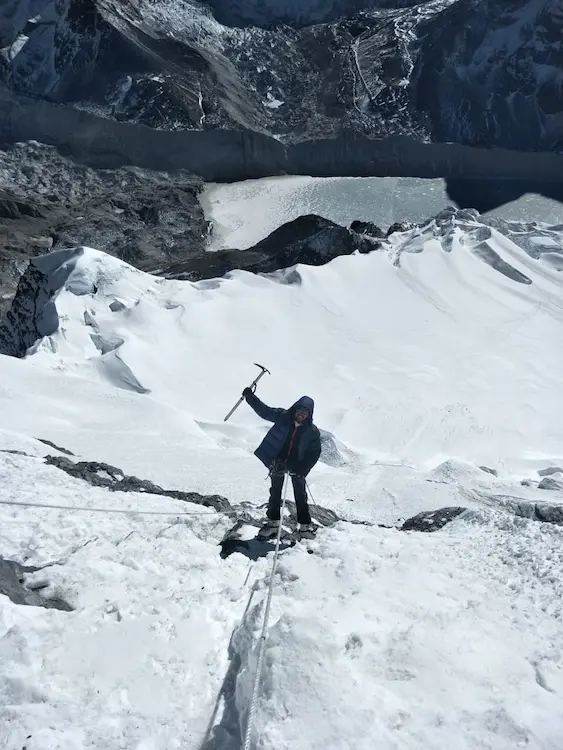
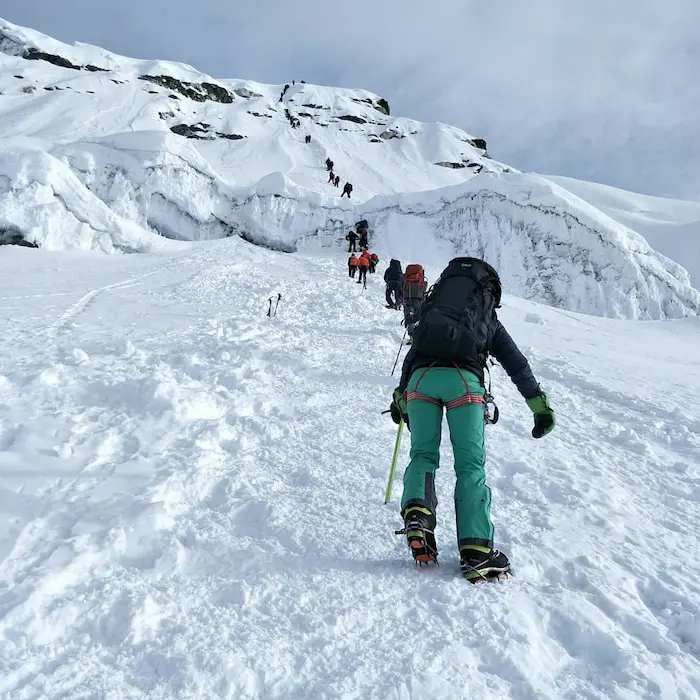

FAQs
Climbing Island Peak is a minor expedition; climbing the peak is so easy that an experienced trekker can successfully reach the summit. Following the guidance of an expert climber and obeying the instructions is important. Trekking up to EBC and back to Dingboche is difficult, challenging due to altitude sickness. Your body will be acclimatized until you reach EBC, which makes it easier to climb Island Peak.
It takes 12 days to reach the Island Peak base camp. On the 13th day, you will go to Island Peak High Camp within 2–3 hours. Climbing Island Peak starts from high camp, with the best weather forecast on the 14th day. Under the guidance of an expert climber, you will reach the summit within 4–5 hours. The entire EBC trekking and climbing island peak is 18 nights and 19 days.
No, mountain climbing experience is not required for climbing Island Peak. But self-preparation for a long walk on rough hills is necessary. Proper practice of walking or running for a few hours every day before 1, 2 months makes you strong enough to climb. Mental and physical fitness are essential. If you are also a also a fresher, the Island Peak Expedition gives you the experience of a mountain climb.
Yes, previous trek experience is required for climbing Island Peak because you will go to EBC before the Ima Tse ascent. So, you need previous trekking experience. To be comfortable walking long trials is most important. If you do not have experience with a trek, you should be well prepared.
Maintenance of physical fitness and long trial walks are basic steps to prepare for the trek. You should do a medical checkup, regular walks longer than 2 hours for about 2–3 months before treks and expeditions, If possible, you can also have a moderate trek to either ABC, Mardi Himal, or Manaslu base camp to get a good experience of the mountain route.
A clean room with a comfortable bed and an attached bathroom is available up to Namche. As altitude increases, tea houses with attached bathrooms are less available or even absent. You should use a twin shared room. In Island Peak base camp and Island Peak high camp, you will stay in tents.
The required equipment for the Island Peak expedition is a helmet, a climbing harness, a belay/rappel device, two locking carabiners, a non-locking ice axe, crampons, climbing carabiners, 6 meters of 16mm tape or 8mm cord, and a Pruslik.
Yes, you can customize the trek. If you don’t have a long-term holiday, if you want to climb the peak but don’t want to go to Everest base camp, then you should consult during the time of booking. We will customize the island climbing duration by changing our route leading to Dingboche without going to EBC. On a customized trip, you can come back to Kathmandu within 15 days. Trekking to EBC is a matter of pride and great support to acclimatize your body. We suggest you not miss EBC, follow the itinerary rather than customize. It gives you full satisfaction to be in the Everest region.
Pasang Lamu Rural Municipality entrance fee and Sagarmatha National Park permit are required for Island peak climb.
You need a passport-size photo and copies of your passport to fill out the permit form. Since you should fill out two permits, you should provide two PP-size photos and two copies of your passport in total.
Age doesn’t determine the ability of people. Mental and physical fitness is more important. Thus there are no criteria of age for climbing Island peak. The age group between 17 to 50 years can easily climb to the summit in a healthy condition of the body. Your strong determination, courage and fitness can lead to the summit at any age.
You will meet your climber in Dingboche, Chhukung, or even at Island Peak Base Camp. Depending on the conditions and free time of a climber, he may join a group from Kathmandu as well.
No, your guide will not climb to the summit. The guide will be with you until Chhukung or Island Peak base camp. You will climb to the summit under the guidance of a climber, come back to Chhukung with the climber, and meet your guide there.In some conditions, your guide will also climb with you along with the climber.
We will hire either a yak or porter to carry climbing equipment to Island Peak base camp. Porter or Yak will transport your equipment back to Chhukung as well. From Island Peak Base Camp, you will be responsible for your equipment because you will be using it to climb mountains.
Yes, it is safe to drink water during the climb. You should drink enough water to hydrate yourself. With increasing altitude, the dryness in the air also increases with low temperatures. To save your body from altitude sickness and dehydration, drinking water frequently is very important.
To book Imja Tse climbing, you should fill in the inquiry form available on the website of the company. You can also contact me directly from the available WhatsApp number and get further information.
Yes, you should pay some advance earlier the expedition. Earlier payment is important for the arrangement for the expedition and confirms your booking.
Yes, ATMs are available in Lukla and Namche Bazaar. You can drag money either in Lukla or Namche Bazaar, as you need extra money for charging and showering.
Yes, you can get a phone signal during the trek and expedition, leaving some high-altitude points. Most of the day, you will get a phone signal and remain in contact with your family. We suggest you take both N cell and NTC sim cards, in the absence of one signal, another will work.
No, it is not possible for solo climbing. You need a climber for guidance and to show you the right path to reach the summit. Arrangements of climbing equipment, permits, and night stays could not be made without your guide and climber.
No, the Island Peak Expedition is a minor climb. There is an almost zero percent chance of death during the climb. To climb the peak, the entire group will wait for the best weather. As climbers get news of the best weather forecast, the climbing begins even at midnight. No, climbing will be done in bad weather to remain safe and protected from danger.
Yes, Wi-Fi is available in the route; all tea houses except some exceptions in high altitudes provide Wi-Fi. But you have to buy a data card to use Wi-Fi.
Yes, you can charge your gadget in all tea houses. Since hydroelectricity is not available at high altitudes, solar power is used. Thus, you should pay an extra $5 to charge your gadget.Some tea houses may take payment per hour, and some may take payment per gadget.
Yes, hot showers are available in all tea houses, but you should pay an extra $5 for the shower.
You can get Mount Everest view from Namche top, Sangbuche, tengbouche, Pagbuche, Gorekshep and Everest base camp and Kalapathar.
Yes, you need sleeping bag. You will have 2 nights stay in tent (one night in Island peak base camp and one night in the Island Peak high camp), without sleeping bag you cannot sleep and face the severe cold nights in the Everest region.
Yes, you can hire sleeping bag. In case you don’t have sleeping bag or you don’t want to bring sleeping bag from your country, you can hire from company or from Thamel.
After the successful climb, you can spend less than half-hour time (10 – 20 min) on the summit because climbing down at right time is very important. After taking photographs and sharing the joy of a successful climb, you should come back to high camp, base camp, and Chhukung on the same day.
No, it is strictly prohibited to take hard drinks during the expedition. High altitude always challenges with altitude sickness. To remain healthy and continue the trek, you should not take hard drinks otherwise you may have to return back without a climb to the Island peak. You cannot reach EBC if you drink hard drinks.
Soft drinks like tea, coffee, hot lemon, hot chocolate, milk, and can juice are good for trekking and expedition.
Yes, you can get western food such as pizza, burgers, French fry, and many more in the Everest region.
Nepali Thali (rice, dal, curry, pickle, salad, pappad), momo, chowmein, thukpa, spaghetti, porridge, egg, pizza, burger, local food are the common food items in the Everest region.
Yes, you should bring a water bottle of your own. To hydrate your body, you should drink water frequently during your walk. Never forget to fill the water bottle before leaving the tea house.
A local guide with a license will be your guide. The company will give you a guide and arrangement of vehicles, tea house, rest day, walking hour, briefing all will be done by your guide.
A porter will carry a weight of 15 kg to 25 kg. Depending on the condition, a porter can carry 30 kg of weight, but you should pay more money for a heavier load.
No, there is no limitation on giving tips to guides and porters. Tips for guides should be given almost twice as much as for porters. The rate is according to your choice, how much you want to give, depends on you.
You will get your climbing equipment in Chhukung. The guide and climber will arrange all the necessary equipment in Chhukung.
It costs 2000–3000 USD to climb the island peak. The cost depends on the trekking company and agency. Always choose a local trekking company to get affordable rates and the best services.
More Info
Island peak climbing is an adventurous expedition, that takes you to the top of Imja Tse and Everest base camp (5364m). It is also a platform for beginners who want to climb other tallest summits (Mt. Everest, Annapurna, Himchuli etc) in the future.
This 19-day long trekking and expedition in the Everest region includes a night at the base camp and the high camp of Island Peak. Seeing the good weather, you will climb the Imja Tse with full preparation under the guidance of expert climber, Sherpa. After a successful climb on the summit of Island Peak, you will go back to the High Camp, the base camp, and Chhukung village.
Keeping peak climbing aside, your trek begins from Lukla to Everest base camp and back to Dingboche. Finally, the summit climb occurs after a night's stay at the base camp and high camp of Island Peak.
Even though it is an expedition, we prefer the Everest base camp trek first and peak climbing on further days for better acclimatization of your body.
We can take this peak climbing as a trek to Everest Base Camp and an expedition to Island Peak Summit. If you only want to go Island peak, customization can be done. You can request customization at the time of booking. A late decision will not work because hotel booking and other arrangements should be done earlier.
A high risk of altitude sickness occurs if you directly go towards Island without going to EBC. In absence of proper acclimatization, your body may not be able to climb high altitude. Thus, we suggest following itinerary rather than customization.
Things to know
Visa
You can get a visa from Nepal Embassy. If the Embassy is not in your country or it's very far for you, then you can directly come to Nepal. Visas are easily available at Tribhuvan International Airport, Nepal. You can take a visa for 1 month or more, according to your plans. Since climbing Island Peak is a 19-day package, you need a 1-month visa.
Accommodation
Three nights in Kathmandu (first two nights and last one night) in a hotel. In the Everest region, the best tea houses with clean rooms and attached bathrooms are available until Namche. In high altitudes, attached bathrooms may be far from the room. You will have two nights (Island peak base camp and Island peak high camp night) in the tent.
Food
Breakfast, lunch, and dinner are included in the package. Nepali, Chinese, western, and local food items are available. You can choose the food of your choice from the menu. In the group trek, limited options, mostly 4, or 5 items of food will be given to choose.
Tea, coffee, milkshakes, porridge, bread items with jam or butter, egg items, bakery items, fruits, and curry is available for breakfast. Nepali thali (lentil, rice, curry, pickle, salad, pappad), mo:mo, chowmein, thukpa, noodles, pasta, pizza, sandwich, spaghetti, etc. are available for Lunch and dinner.
Island Peak with Everest Base Camp Trek Map
The trekking route starts from Lukla. Pakhding, Namche, Tengboche, Pherichhe, Lobuche, Gorakshep (EBC and Kala pathhar), Dingboche, Chhukung, Island peak base Camp, and Island peak high camp are night stay zone. From Island Peak High camp, you will climb the island peak summit as soon as you get the best weather forecast.
After climbing the summit, you will return to Chhukung, and Tengboche, Namche, and Lukla will become further nightstay points. In this way, your trek and expedition in the Everest region will be completed after returning Kathmandu.
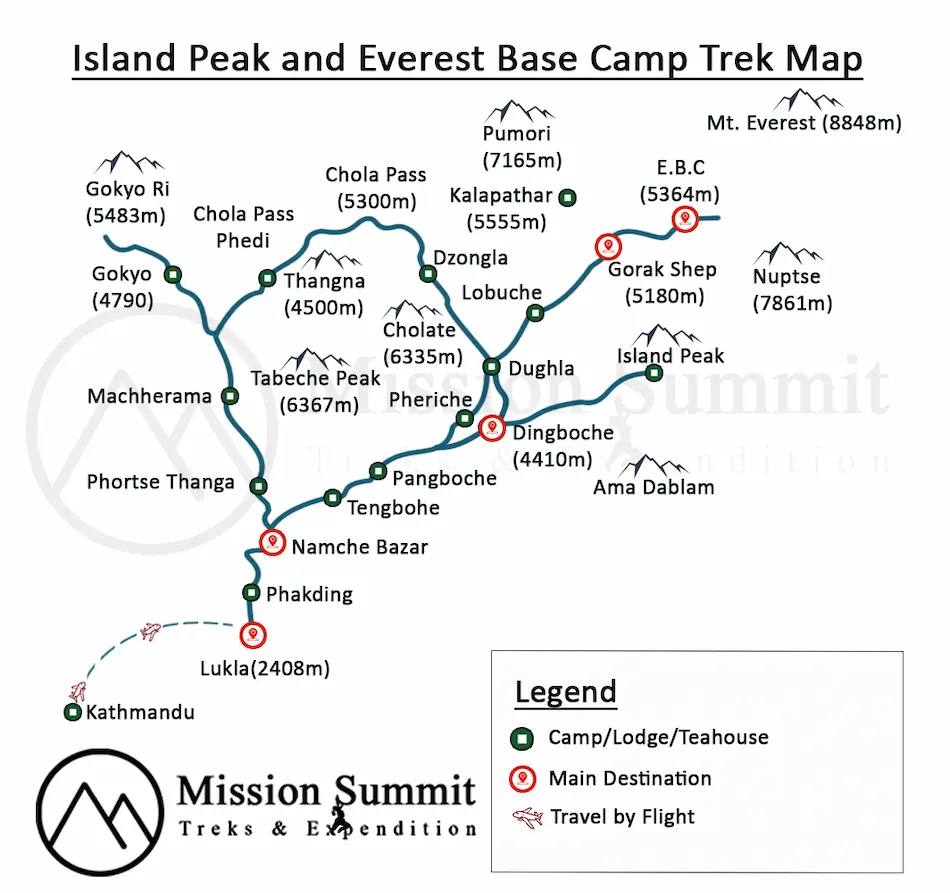
Most commonly, you will walk on the bank of Dudhkoshi, somewhere stone-paved and somewhere rocky path, uphills and downhills, and cross many suspension bridges over the river.
The trekking route is decorated with a prayer flag, monasteries, mani walls, chortens, and mountainous surroundings. The smiling white Himalaya ranges keep energized. blooming rhododendron, chirping of birds, flowing river, innocent Sherpas, Yak shed and challenging altitude make your time the best.
Equipment for Island Peak Climb
The following equipment is required for climbing Island Peak:
- helmet
- Climbing harness
- Belay/rappel device
- Locking carabiners x2
- Non-Locking Ice Axe
- Crampons
- Climbing carabiners x1
- 6 meters of 16mm tape or 8mm cord
- Prusik
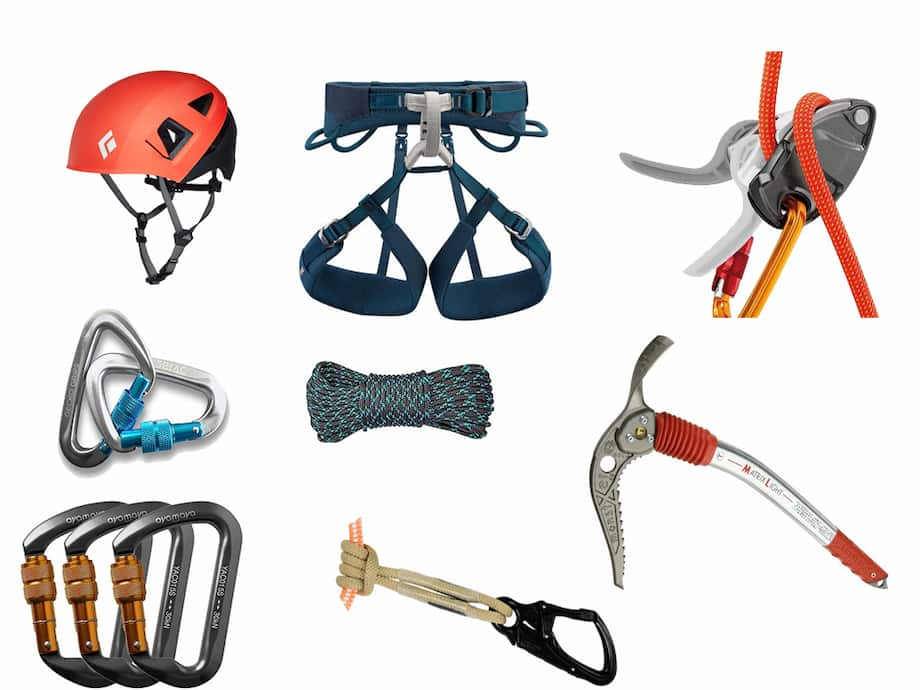
Preparation for Island Peak climb
Imja Tse is a minor peak to climb. You don’t need to be an expert and experience is not compulsory. Mentally and physically fit people can easily do this task under the guidance of Sherpa. An expert will be guiding you from Island Peak base camp to the summit and back to base camp.
Before climbing the peak, your guide or Sherpa will give you instructions about the use of equipment, rules, and method of climbing. It is very important to apply the instruction to be safe and attain a successful climb.
The best time for Island Peak climb
Spring (March, April, and May) and autumn (August, September, and October) are the best times for climbing Island Peak. Pleasant weather and bearable temperature become favorable for climbing Island Peak.
Never choose mid-summer or winter because snowfall, rainfall, and extremely low temperatures increase the risk on the mountain. We could not attempt a successful trek or climb during bad weather conditions.
Transportation
Flight on the Kathmandu-Lukla route, private taxi, or car on the airport-hotel route. The entire trek will be done on foot.
Clothing
Clothing is very important for peak climbing and expeditions. You need to select the best clothing as recommended below:
- Good wind/rain jacket
- Warm fleece jacket or jersey
- Good boots, either light-weight trekking boots or light full leather boots
- Good sleeping bag (which can be rented or bought in Kathmandu)
- A comfortable day pack, preferably with a waistband
- Fleece jacket or pullover
- Fleece Wind-Stopper jacket (optional)
- Waterproof (preferably breathable fabric) shell jacket
- Down vest and/or jacket (optional)
- Lightweight gloves
- Heavyweight gloves or mittens with a waterproof shell outer
- Sun hat or scarf
- Light balaclava or warm fleece hat
- Sunglasses with UV protection
- T-shirts
- Underwear
- Hiking shorts
- Light and expedition-weight thermal bottoms
- Fleece or wool pants
- Waterproof (preferably breathable fabric) shell pants
- Thin, lightweight inner socks
- Thick, warm wool hiking socks
- Hiking boots with spare laces
- Camp shoes (sneakers and/or sandals)
Other optional necessary equipment:
- Headlamp (e.g. Petzl Zoom) with spare bulbs and batteries
- Small pad or combination lock-to-lock trek bag
- Basic First Aid Kit (We also provide a comprehensive first aid medical kit and Oximeter)
- Large plastic bags - for keeping items dry inside trek bag
- Day pack (approximately 2500 to 3000 cubic inches)
- Water bottles (2 bottles recommended)
- Toiletries
- Small wash towel
Altitude Sickness
This is a kind of illness that is caused by ascent to high altitudes. The symptoms will occur within 6 to 24 hours of achieving a high altitude. Altitude sickness is fatal and can result in death if not treated in time. You need to stay alert to any of the symptoms that occur.
Symptoms
- Headache
- Nausea and vomiting
- Dizziness
- Tiredness
- Loss of appetite
- Upset stomach
- Feeling unsteady
- Shortness of breath
- Increased heart rate
- Difficulty sleeping
An effective measure to recover from early AMS
If you happen to notice any of the symptoms, follow the guideline mentioned below:
- Do not climb any higher for the next 48 hours
- Descend to a lower altitude if possible
- Take complete rest until you feel well
- Do not exercise
- Do not smoke
- Drink plenty of water
- Take external oxygen supply if necessary
- Take anti-sickness medicines
If you see no improvement in your health within 48 hours, you will have to be immediately deported to the city for medical support.
Preventive Measures
There is no way to train your body prior to trekking so as to adapt to the high altitude. Some ways in which you can prevent it are as follows:
- Take plenty of rest
- Ascend slowly and gradually as you reach higher
- keep yourself hydrated
- Eat high-calorie food
- Do not smoke, drink or consume tranquilizing medicines
Insurance
During emergencies like acute altitude sickness or a natural calamity, you might have to be immediately deported to a helicopter. Health insurance will cover the deportation cost that needs to be purchased before you start the trek.
Trekking option
- Solo trekking with a private guide, porter, and climber.
- Trekking with only a Guide and climber.
- Trekking with Guide and Porter.
- Trekking with Group with guide & Porter.
Note
You will meet a climbing guide either in Dingboche, Chhuking, Lukla, or Kathmandu. If you don't like to take Island Peak with the Everest Base Camp Trek package, then we also offer Imja Tse climbing from Chhukung.
Who will be our Island Peak Expedition Guide?
Your climbing guide will be Pasang Sherpa, who has summited Mount Everest two times and has climbed other 8000-meter peaks as well. If you want to know more about your guide, please go to our team section.
Difficulty
Climbing Island Peak is moderately difficult and graded as 2B in the Russian Alpine Grading System. Similarly, it is ‘AD’ (Assez Difficile/fairly difficult) route in French Adjective System. The difficulty of Island peak is leveled in class 5 based on Yosemite Decimal System, whereas it is leveled in class III to IV in UIAA grading system. Overall, the grading system represents Island peak with moderate climbing route and easy moves. The terrain includes steeper and more defined rock faces. Therefore, you must learn basic rock-climbing techniques to reach on the Island Peak summit.
Island Peak versus Mera Peak Climbing
Both Island peak and Mera peak are amazing trekking peaks of Everest region. The overall comparison between trekking and expeditions to Island Peak and Mera Peak is shown in Table 1.
Table 1: Island peak versus Mera Peak
| Features | Island Peak climb | Mera Peak Climb |
| Highest elevation | 6,189 meters (20,305 feet) | 6,654 meters (20,830.71 feet) |
| Location | 27.709025°N and 86.867781°E Sagarmatha National Park | 27.924199° N and 86.937304°E Makalu Barun National Park |
| Duration | 19 days | 18 days |
| Trekking - 14 days | Trekking - 13 days | |
| Climbing - 1 day | Climbing - 1 day | |
| Transportation – 4 days | Transportation – 4 days | |
| Difficulty | AD (Assez Difficile/fairly difficult) in Alpine Grading System | PD (Peu Difficile/little Difficulty) in Alpine Grading System |
| Permit | Sagarmatha National Park Permit | Makalu Barun National Park Entry Permit |
| Khumbu Pasang Lhamu Rural Municipality Entrance Permit | Khumbu Pasang Lhamu Rural Municipality Entrance Permit | |
| Island Peak expedition permit | Mera peak climbing permit | |
| Best time | March, April, May, September, October and November | March, April, May, September, October and November |
| Cost | 2200 USD | 2150 USD |
| Accommodation | Tea house and Camping on mountain | Tea house and Camping on mountain |
The comparison chart (Table 1) shows both Island Peak and Mera Peak are suitable for trekking and expeditions. Beginners with the best preparation for rock climbing and handling the ropes are necessary for climbing these peaks.
Reviews
No Reviews






